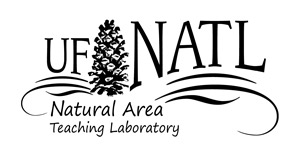| UF Academic Use | Public Use | Family Fun and K-12 Education |

History
Early history
Currently the earliest information about NATL's site is that it was purchased by the State of Florida in 1944. In that year, C. C. Richbourg and wife sold the State 192 acres in the southwest portion of section 12, township 10S, range 19E. A portion of this parcel is now NATL.
1944 to 1990
Aerial photographs from this period show how NATL's site changed greatly during the first 46 years of University of Florida's stewardship. These photographs are interpreted by George Freeman and Garry Lockerman in a 1999 interview.
Birth of NATL
In May 1993, the urbanization of areas north and east of what is now NATL stimulated the formation of a Planning Group, consisting of 15 persons who wanted 45 acres of the tract now known as NATL-west designated a “campus natural area and outdoor teaching laboratory.” The Planning Group selected Dana Griffin (Botany), Joe Schaefer (Wildlife Ecology & Conservation), and Tom Walker (Entomology & Nematology) to draft a proposal to that effect. A draft was completed, circulated, and revised. The final proposal was endorsed by faculty in all departments that were likely users of the area and submitted to Campus Planning in July 1993. It was endorsed by the University Land-Use and Facilities Planning Committee in May 1994.
With encouragement from IFAS Dean for Academic Programs Larry J. Connor, a Natural Area Advisory Committee, with members representing the principal users, was organized in September 1994. Its charge was to plan the development and management of NATL.
Additions to NATL
In 1997, NATL was allowed to annex about an acre of the Surge Area immediately north of the mini warehouses. In 2005, as part of the 2005-2015 update of the Campus Master Plan, NATL was expanded to include the 11 acres that became NATL-east and west of Natural Area Drive the boundaries of NATL were redrawn to annex about three more Surge Area acres. For a pictorial summary of the development of NATL, see Principal improvements to NATL: 1994-date.
Managment, maintenance, and funding
When the Natural Area Advisory Committee [NAAC] was formed in September 1994 (see Birth of NATL above), it had no status with UF administration other than an IFAS dean and no official administrative oversight, but in 1996, when NAAC sought to put a fence along NATL's (and UF's) south border, it was discovered by Tigert Hall. The result was that NAAC agreed to be supervised by the Lakes, Vegetation and Landscaping Committee (LVLC), an official UF committee whose responsibilities include making recommendations to UF Administration on the management of natural areas. NAAC would keep LVLC informed of its activities and plans and the Chair of LVLC would become an ex officio member of NAAC. This supervision brought no commitments for support, and the faculty members who founded NATL continued to see to its routine maintenance. For capital improvements to NATL, NAAC sought and received funds from administrators who supported NATL's academic goals.
As NATL developed, its needs for routine support increased. In March 2001, Provost David Colburn approved these policies: (1) The Natural Area Advisory Committee (NAAC), consisting of at least one representative from each department or other unit making significant use of NATL and the Chair of the Lakes, Vegetation and Landscaping Committee, will recommend management plans and seek their implementation. Each fall the Chair of NAAC will send a written report of the Committee's activities for the previous school year to appropriate administrators and will report in person to the Lakes, Vegetation, and Landscaping Committee. (2) NAAC and PPD will work cooperatively to ensure the maintenance of NATL. Each will do those tasks that it can handle most efficiently. The Chair of NAAC will communicate directly with PPD and the Vice President of Administrative Affairs regarding maintenance of NATL. (3) NAAC will ask the Provost for funds to cover its routine operations. Each such request will be accompanied by a report of all NAAC expenditures not previously documented. For major projects, NAAC will also request the Provost's support, but with copies to the Vice President of Administrative Affairs, the Vice President for Agriculture and Natural Resources, and the Deans of the Colleges of Agricultural and Life Sciences, Liberal Arts and Sciences, Engineering, and Education.


